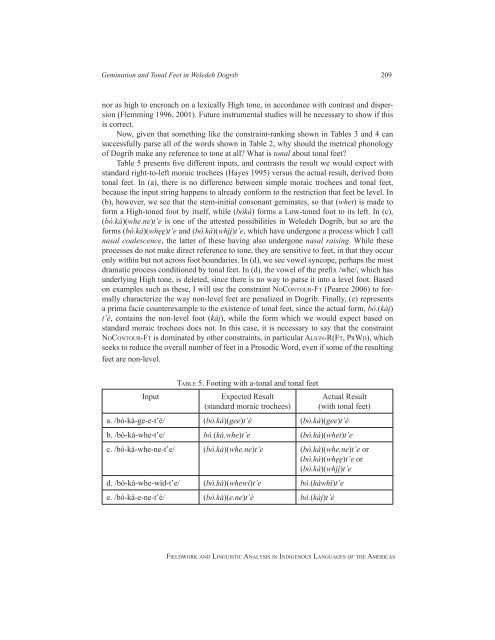Fieldwork and Linguistic Analysis in Indigenous ... - ScholarSpace
Fieldwork and Linguistic Analysis in Indigenous ... - ScholarSpace
Fieldwork and Linguistic Analysis in Indigenous ... - ScholarSpace
You also want an ePaper? Increase the reach of your titles
YUMPU automatically turns print PDFs into web optimized ePapers that Google loves.
Gem<strong>in</strong>ation <strong>and</strong> Tonal Feet <strong>in</strong> Weledeh Dogrib 209<br />
nor as high to encroach on a lexically High tone, <strong>in</strong> accordance with contrast <strong>and</strong> dispersion<br />
(Flemm<strong>in</strong>g 1996, 2001). Future <strong>in</strong>strumental studies will be necessary to show if this<br />
is correct.<br />
Now, given that someth<strong>in</strong>g like the constra<strong>in</strong>t-rank<strong>in</strong>g shown <strong>in</strong> Tables 3 <strong>and</strong> 4 can<br />
successfully parse all of the words shown <strong>in</strong> Table 2, why should the metrical phonology<br />
of Dogrib make any reference to tone at all? What is tonal about tonal feet?<br />
Table 5 presents five different <strong>in</strong>puts, <strong>and</strong> contrasts the result we would expect with<br />
st<strong>and</strong>ard right-to-left moraic trochees (Hayes 1995) versus the actual result, derived from<br />
tonal feet. In (a), there is no difference between simple moraic trochees <strong>and</strong> tonal feet,<br />
because the <strong>in</strong>put str<strong>in</strong>g happens to already conform to the restriction that feet be level. In<br />
(b), however, we see that the stem-<strong>in</strong>itial consonant gem<strong>in</strong>ates, so that (whet) is made to<br />
form a High-toned foot by itself, while (bòkà) forms a Low-toned foot to its left. In (c),<br />
(bò.kà)(whe.ne)t’e is one of the attested possibilities <strong>in</strong> Weledeh Dogrib, but so are the<br />
forms (bò.kà)(whęę)t’e <strong>and</strong> (bò.kà)(whįį)t’e, which have undergone a process which I call<br />
nasal coalescence, the latter of these hav<strong>in</strong>g also undergone nasal rais<strong>in</strong>g. While these<br />
processes do not make direct reference to tone, they are sensitive to feet, <strong>in</strong> that they occur<br />
only with<strong>in</strong> but not across foot boundaries. In (d), we see vowel syncope, perhaps the most<br />
dramatic process conditioned by tonal feet. In (d), the vowel of the prefix /whe/, which has<br />
underly<strong>in</strong>g High tone, is deleted, s<strong>in</strong>ce there is no way to parse it <strong>in</strong>to a level foot. Based<br />
on examples such as these, I will use the constra<strong>in</strong>t nocontour-ft (Pearce 2006) to formally<br />
characterize the way non-level feet are penalized <strong>in</strong> Dogrib. F<strong>in</strong>ally, (e) represents<br />
a prima facie counterexample to the existence of tonal feet, s<strong>in</strong>ce the actual form, bò.(kàį)<br />
t’è, conta<strong>in</strong>s the non-level foot (kàį), while the form which we would expect based on<br />
st<strong>and</strong>ard moraic trochees does not. In this case, it is necessary to say that the constra<strong>in</strong>t<br />
nocontour-ft is dom<strong>in</strong>ated by other constra<strong>in</strong>ts, <strong>in</strong> particular align-r(ft, Prwd), which<br />
seeks to reduce the overall number of feet <strong>in</strong> a Prosodic Word, even if some of the result<strong>in</strong>g<br />
feet are non-level.<br />
table 5. Foot<strong>in</strong>g with a-tonal <strong>and</strong> tonal feet<br />
Input Expected Result<br />
(st<strong>and</strong>ard moraic trochees)<br />
Actual Result<br />
(with tonal feet)<br />
a. /bò-kà-ge-e-t’è/ (bò.kà)(gee)t’è (bò.kà)(gee)t’è<br />
b. /bò-kà-whe-t’e/ bò.(kà.whe)t’e (bò.kà)(whet)t’e<br />
c. /bò-kà-whe-ne-t’e/ (bò.kà)(whe.ne)t’e (bò.kà)(whe.ne)t’e or<br />
(bò.kà)(whęę)t’e or<br />
(bò.kà)(whįį)t’e<br />
d. /bò-kà-whe-wìd-t’e/ (bò.kà)(whewì)t’e bò.(kàwhì)t’e<br />
e. /bò-kà-e-ne-t’è/ (bò.kà)(e.ne)t’è bò.(kàį)t’è<br />
fieldwork <strong>and</strong> l<strong>in</strong>guistic analysis <strong>in</strong> <strong>in</strong>digenous languages of the americas

















